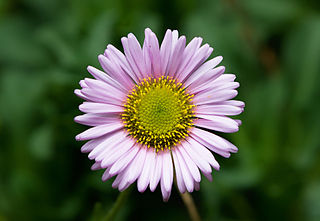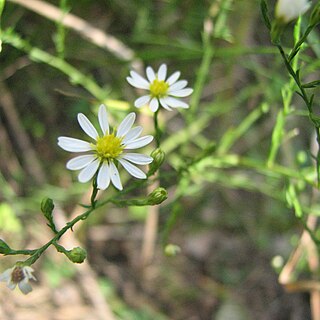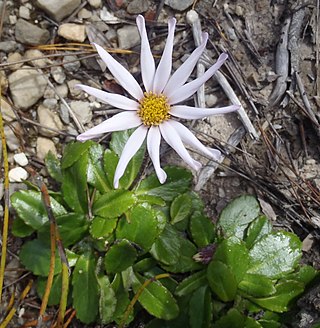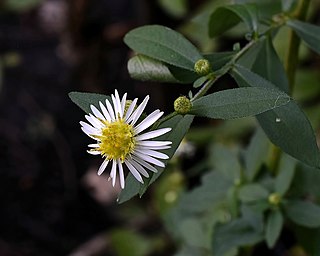
Symphyotrichum novae-angliae is a species of flowering plant in the aster family (Asteraceae) native to central and eastern North America. Commonly known as New England aster, hairy Michaelmas-daisy, or Michaelmas daisy, it is a perennial, herbaceous plant usually between 30 and 120 centimeters tall and 60 to 90 cm wide.

Oclemena is a small genus of North American flowering plants in the tribe Astereae within the family Asteraceae.

Symphyotrichum is a genus of over 100 species and naturally occurring hybrids of herbaceous annual and perennial plants in the composite family Asteraceae, most which were formerly treated within the genus Aster. The majority are endemic to North America, but several also occur in the West Indies, Central and South America, as well as in eastern Eurasia. Several species have been introduced to Europe as garden specimens, most notably New England aster and New York aster.

Astereae is a tribe of plants in the family Asteraceae that includes annuals, biennials, perennials, subshrubs, shrubs, and trees. They are found primarily in temperate regions of the world. Plants within the tribe are present nearly worldwide divided into over 250 genera and more than 3,100 species, making it the second-largest tribe in the family behind Senecioneae.

Symphyotrichum lateriflorum is a species of flowering plant in the aster family (Asteraceae). Commonly known as calico aster, starved aster, and white woodland aster, it is native to eastern and central North America. It is a perennial and herbaceous plant that may reach heights up to 120 centimeters and widths up to 30 centimeters.

Ionactis alpina is a species of flowering plant in the family Asteraceae known by the common name lava aster. It is native to western United States from California to Montana, where it grows in dry areas.

Ionactis linariifolia also known as the flax-leaf ankle-aster, flaxleaf whitetop or simply aster is a North American species of plants in the family Asteraceae.

Canadanthus is a North American monotypic genus of flowering plants in the family Asteraceae. The only species is Canadanthus modestus, commonly known as great northern aster or western bog aster. It is native to most of Canada and to northern parts of the United States.

Doellingeria is a genus of flowering plants in the family Asteraceae. It contains species formerly included in Aster but now considered to be a distinct genus. They are known commonly as tall flat-topped asters or whitetops.

Symphyotrichum depauperatum, commonly known as serpentine aster or starved aster, is a rare species in the family Asteraceae adapted to serpentine barrens, an ecosystem with a high concentration of toxic metals in the soil. It has been found in Pennsylvania, Maryland, and on some diabase glades in North Carolina. It grows to 50 centimeters and has white ray florets surrounding a center of yellow disk florets.

Mairia is a genus of perennial herbaceous plants assigned to the family Asteraceae. All species have leathery, entire or toothed leaves in rosettes, directly from the underground rootstock, and one or few flower heads sit at the top of the stems that carry few bracts. These have a whorl of white to mauve ray florets surrounding yellow disc florets in the centre. In general, flowering only occurs after the vegetation has burned down. The six species currently assigned to Mairia are endemic to the Western Cape and Eastern Cape provinces of South Africa. Some of the species are called fire daisy in English and vuuraster in Afrikaans.
Chiliotrichiopsis is a genus of flowering plants in the family Asteraceae. It is native to the Andes, where it is distributed in Peru, Bolivia, and Argentina. Species occur in the mountains up to 4200 meters in elevation.

Symphyotrichum lanceolatum is a species of flowering plant in the family Asteraceae native to North America. Common names include panicled aster, lance-leaved aster, and white panicled aster. It is a perennial, herbaceous plant that may reach 1.5 meters tall or more, sometimes approaching 2 m. The lance-shaped leaves are generally hairless but may feel slightly rough to the touch on the top because of tiny bristles. The flowers grow in clusters and branch in panicles. They have 16–50 white ray florets that are up to 14 millimeters long and sometimes tinged pink or purple. The flower centers consist of disk florets that begin as yellow and become purple as they mature.

Symphyotrichum dumosum is a species of flowering plant of the family Asteraceae commonly known as rice button aster and bushy aster. It is native to much of eastern and central North America, as well as Haiti and Dominican Republic. It is a perennial, herbaceous plant that may reach a height of 1 meter.

Ionactis caelestis, the Spring Mountain aster, is a rare North American species in the family Asteraceae. It has been found only in southern Nevada in the western United States.

Symphyotrichum robynsianum is a species of flowering plant in the family Asteraceae native to northeastern North America. Common names include Robyn's aster and long-leaved aster.

Symphyotrichum ontarionis is a species of flowering plant in the family Asteraceae native to eastern North America. Commonly known as Ontario aster and bottomland aster, it is a perennial, herbaceous plant that may reach heights of 120 centimeters. Each flower head has many tiny florets put together into what appear as one.

Sanrobertia is a genus of flowering plants within the subtribe Symphyotrichinae of the family Asteraceae. It is monotypic, meaning there is only one species within the genus. Sanrobertia gypsophila is a rare endemic known only from Nuevo León, Mexico.

Felicia is a genus of small shrubs, perennial or annual herbaceous plants, with 85 known species, that is assigned to the daisy family. Like in almost all Asteraceae, the individual flowers are 5-merous, small and clustered in typical heads, and which are surrounded by an involucre of, in this case between two and four whorls of, bracts. In Felicia, the centre of the head is taken by yellow, seldom whitish or blackish blue disc florets, and is almost always surrounded by one single whorl of mostly purple, sometimes blue, pink, white or yellow ligulate florets and rarely ligulate florets are absent. These florets sit on a common base and are not individually subtended by a bract. Most species occur in the Cape Floristic Region, which is most probably the area where the genus originates and had most of its development. Some species can be found in the eastern half of Africa up to Sudan and the south-western Arabian peninsula, while on the west coast species can be found from the Cape to Angola and one species having outposts on the Cameroon-Nigeria border and central Nigeria. Some species of Felicia are cultivated as ornamentals and several hybrids have been developed for that purpose.


















